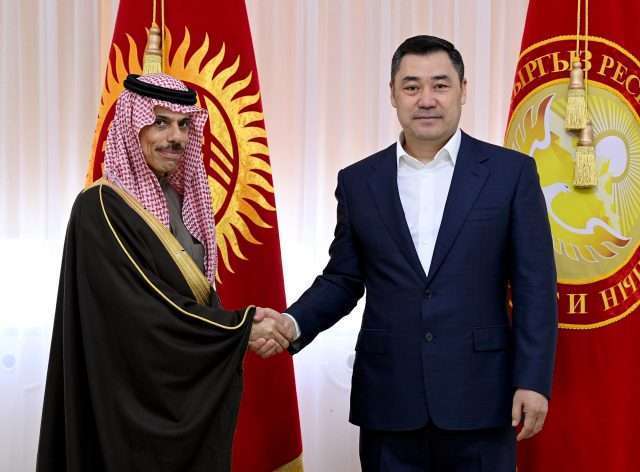Saudi Arabia and Kyrgyzstan enhanced economic cooperation and investment opportunities

Saudi Arabia and Kyrgyzstan discussed investments partnership confirming Riyadh’s desire to improve its economic presence in the Kyrgyz market and Central Asia and Bishkek’s necessity to diversify its financial partners and foreign investors.
On March 21st, 2022, for the first time in Kyrgyz-Saudi relations, Foreign Minister of the Kingdom of Saudi Arabia Faisal ibn Abdullah ibn Abdul-Aziz Al Saud arrived in Bishkek on a working visit to meet with the President of Kyrgyzstan Sadyr Japarov and discuss issues of investments partnership.
During the meeting with the Kyrgyz leader, the Saudi prince expressed his readiness to increase efforts in the field of investment cooperation. This year, representatives of the National Investment Agency under the President of Kyrgyzstan will visit Saudi Arabia to discuss the prospects for cooperation in the investment and trade and economic spheres.
The Saudi minister stressed that the Kingdom is considering importing environmentally friendly products from Kyrgyzstan. In addition, Riyadh is ready to expand its partnership with Bishkek in the agricultural and tourism sectors.
On the same day, the Minister of Foreign Affairs of Saudi Arabia held talks with Prime Minister Akylbek Zhaparov and his Kyrgyz counterpart Ruslan Kazakbaev.
Why does it matter?
Kyrgyzstan needs foreign investments to develop its economy and support national infrastructural projects. The Russian Federation and China have been the leading commercial partners and investors in the Kyrgyz economy, but Bishkek has recently looked at new investors to diversify its economy and domestic market and decrease its dependence on Moscow and Beijing.
Among Central Asian republics, Kyrgyzstan financially relies more on Chinese investments allowing Beijing to exploit this economic dependence to affirm its presence and influence, especially after the U.S. troops’ withdrawal from Afghanistan, which marked the beginning of a more aggressive Chinese strategy based on promoting economic and security cooperation with Kyrgyzstan (China and Kyrgyzstan strengthened security cooperation). Indeed, Kyrgyzstan’s foreign debt is reportedly as much as $5 billion, and more than 40 % of that ($1.8 billion) is owed to the Export-Import Bank of China for a series of infrastructure projects over the last decade under the guise of the Belt and Road Initiative (BRI).
Looking at the regional dynamics, Kyrgyzstan is part of the Russian influence sphere called blizhnee zarubezhe (near abroad), a member of the Eurasian Economic Union and the Collective Security Treaty Organisation (CSTO). Although Moscow and Bishkek have always underlined their strong political and economic cooperation, the Ukraine conflict and the Western sanctions might have convinced the Kyrgyz Government to decrease its dependence on Russian investments and influence and consider other partners in Europe and the Middle East.
Like other Gulf countries, Saudi Arabia aims to become more involved in the regional dynamics exploiting foreign direct investments (FDIs) in infrastructural projects, boosting trade exchange with local actors, and using the card of Islam to gain popularity among the local population. In this context, Saudi Arabia expressed its interests in the Kyrgyz economy, financial market and investment opportunities exploiting Bishkek’s desire and necessity to diversify its investors and partners.
Central Asia has proven to play a strategic role in the Eurasian geopolitical chessboard, attracting regional and international actors interested in promoting their political agenda. Indeed, Riyadh’s significant involvement in Central Asia should consider the current geopolitical regional dynamics represented by Tehran’s regional policy (Tehran meeting on Afghanistan underlines Iranian regional strategy), the rising Emirati role in the regional investment projects (Geopolitics of UAE investments in Central Asia), Ankara’s Pan-Turkism (Turkey and pan-Turkism in Central Asia: challenges for Russia and China), Moscow’s Eurasian Economic Union and CSTO (CIS meeting and the Russian strategy in Eurasia), Beijing’s Belt and Road Initiative (China confirms its commitment and strategy in Central Asia), Washington’s soft power and new strategy in Central Asia (Geopolitics of the U.S. strategy in Central Asia) and Brussels’ attempt to become more involved into local socio-cultural and economic projects (Italy and Kyrgyzstan strengthened their relations; Tajikistan and the European Union discussed an expanded cooperation agreement).
